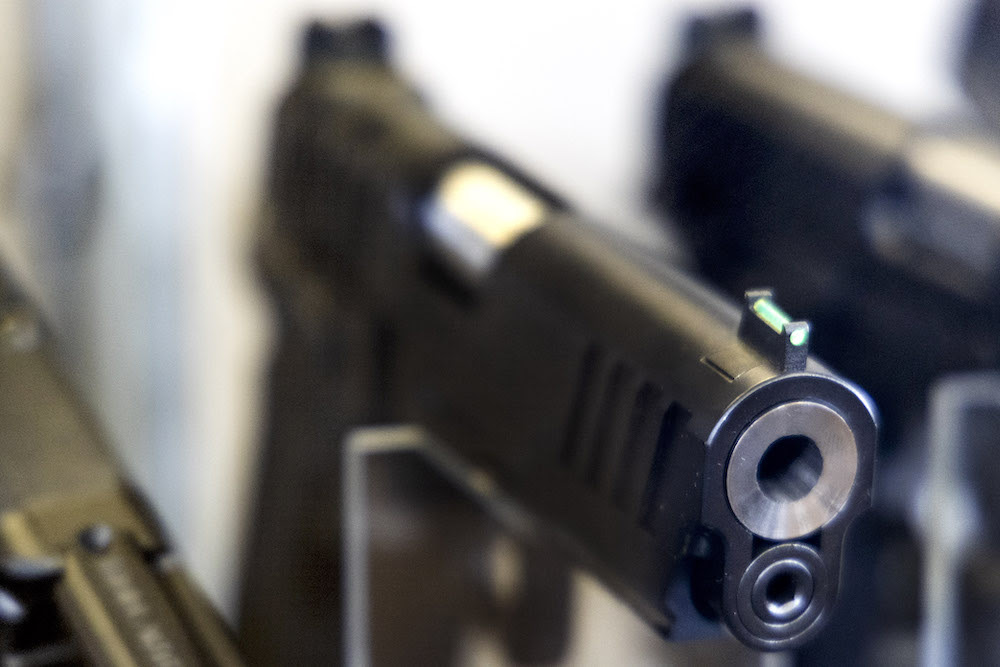A new study finds the prevalence of firearms in the United States, not mental illness, is the driving force in the number of firearm-related deaths. (Photo by Aristide Economopoulos/NJ Monitor)
If you or someone you know is struggling with thoughts of suicide or a mental health crisis, call or text 988 for free, immediate support 24/7.
The prevalence of firearms in the U.S. – not mental illness – is driving the surge in gun deaths across the country, a new study concludes.
The research led by an Oregon Health & Science University professor looked at mental health conditions and firearm deaths in the U.S. and 40 other countries. It found the U.S. had 20 times more deaths by firearms than the other countries even when rates of mental illness were the same.
“We have the same degree of mental health issues as other countries, but our firearm death rate is far greater and continuing to increase,” said Dr. Archie Bleyer, a clinical research professor at OHSU and lead author of the study. “In most of the countries, firearms deaths are decreasing.”
Other researchers have looked at mental illness and gun ownership but this study is the first to include this many other countries, according to Erik Robinson, a spokesman for OHSU.
Bleyer’s findings, which were published in the journal PLOS One, challenge the common assumption that mental health disorders are to blame for the high rate of firearm deaths in the U.S., which have risen 23% since 2000 while dropping 27% in other countries.
Bleyer, a pediatric oncologist, dug into the issue after when his 12-year-old grandson’s classmate died by a firearm. He said he knew the boy’s mother and her son “left a note and used the gun, but didn’t need to die because he had a bad day.”
Suicides account for most firearm deaths in Maine, and are most prevalent among men. In 2021, 178 people died by firearms in Maine, and of those 158 were suicides, according to Maine Center for Disease Control and Prevention data.
The study found that policies on gun ownership can reduce firearm deaths. It said that countries with policies that decrease the the number of guns owned by residents, including Switzerland, Australia, New Zealand, Canada and Israel, reduced their firearm death rates.
In Australia, the government drove down the rate of gun ownership with a government program that purchased firearms from gun owners. Other countries take steps like limit the number of firearms an individual can own or ban assault weapons.
Congress has struggled to enact legislation cracking down on gun ownership, with strong resistance from gun rights activists and many Republicans. Two years ago, following the mass school shooting in Uvalde, Texas that left 21 people dead, including 19 students, Congress passed a law to expand background checks for gun buyers.
After the deadly mass shooting in Lewiston last year, Maine lawmakers passed several gun safety reforms, including a 72-hour-waiting period and a sweeping public safety bill that, among other provisions, updated the state’s yellow flag law, requires background checks for private sales, improved data collection on violence-related injuries and deaths and established a statewide network of crisis receiving centers.
Bleyer said efforts that decrease the number of firearms in the country are critical to stemming gun deaths. He noted that the U.S. has 4% of the world’s population, but almost one-quarter of the world’s firearms, and half of all non-military assault weapons are in the U.S.
Actions that reduce the level of gun ownership will help reduce the deaths that are linked to suicides and accidents, he said.
“By reducing prevalence, we should be able to reduce the firearm death rate,” he said.
Another issue is the ease of access to firearms, especially for households with children. He and other experts recommend safe storage devices that can deter people.
“Even though parents more often than not think their gun is locked and their children do not know where it is or how to unlock it, they’re usually wrong,” Bleyer said. “More often than not, when tested, their children know where it is, how to get into it and they often will play with it when their parents are gone.”
At the same time, Bleyer stressed his study doesn’t change the mental health crisis and lack of treatment that plagues many states.
“We do have significant mental health problems, there is no doubt about that,” he said. “We don’t have enough mental health providers, facilities, treatments. It’s the way that we have facilitated killing ourselves that leads to death with firearms where we take this to the extreme.”
Other contributors to this study are Dr. Stuart Siegel, of the Keck School of Medicine of the University of Southern California; Dr. Jaime Estrada, of Texas Doctors for Social Responsibility; and Dr. Charles R. Thomas Jr. of Geisel School of Medicine at Dartmouth and previous chair of the Department of Radiation Medicine in the OHSU School of Medicine.
Lauren McCauley contributed reporting to this piece.
This story was originally published by Oregon Capital Chronicle. Like Maine Morning Star, Oregon Capital Chronicle is part of States Newsroom, a nonprofit news network supported by grants and a coalition of donors as a 501c(3) public charity. Oregon Capital Chronicle maintains editorial independence. Contact Editor Lynne Terry for questions: info@oregoncapitalchronicle.com. Follow Oregon Capital Chronicle on Facebook and X.
SUPPORT NEWS YOU TRUST.

